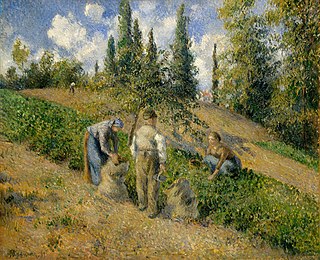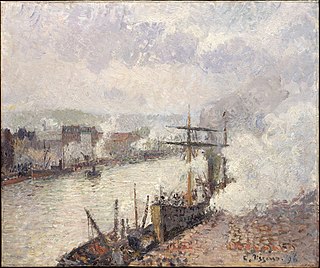
Oscar-Claude Monet was a French painter and founder of impressionist painting who is seen as a key precursor to modernism, especially in his attempts to paint nature as he perceived it. During his long career, he was the most consistent and prolific practitioner of impressionism's philosophy of expressing one's perceptions before nature, especially as applied to plein air (outdoor) landscape painting. The term "Impressionism" is derived from the title of his painting Impression, soleil levant, exhibited in 1874 initiated by Monet and his associates as an alternative to the Salon.

Jacob Abraham Camille Pissarro was a Danish-French Impressionist and Neo-Impressionist painter born on the island of St Thomas. His importance resides in his contributions to both Impressionism and Post-Impressionism. Pissarro studied from great forerunners, including Gustave Courbet and Jean-Baptiste-Camille Corot. He later studied and worked alongside Georges Seurat and Paul Signac when he took on the Neo-Impressionist style at the age of 54.

Birmingham Museum and Art Gallery (BM&AG) is a museum and art gallery in Birmingham, England. It has a collection of international importance covering fine art, ceramics, metalwork, jewellery, natural history, archaeology, ethnography, local history and industrial history.
The year 1896 in art involved some significant events.

Charles Angrand was a French artist who gained renown for his Neo-Impressionist paintings and drawings. He was an important member of the Parisian avant-garde art scene in the late 1880s and early 1890s.
Overcast is the state of the sky when it is covered by clouds; a type of weather.

Haystacks is the common English title for a series of impressionist paintings by Claude Monet. The principal subject of each painting in the series is stacks of harvested wheat. The title refers primarily to a twenty-five canvas series which Monet began near the end of the summer of 1890 and continued through the following spring, though Monet also produced five earlier paintings using this same stack subject. A precursor to the series is the 1884 Haystack Near Giverny.

The Rouen Cathedral series was painted in the 1890s by French impressionist Claude Monet. The paintings in the series each capture the façade of Rouen Cathedral at different times of the day and year and reflect changes in its appearance under different lighting conditions.

The Musée des Beaux-Arts de Rouen is an art museum in Rouen, in Normandy in north-western France. It was established by Napoléon Bonaparte in 1801, and is housed in a building designed by Louis Sauvageot and built between 1877, and 1888. Its collections include paintings, sculptures, drawings and objets d'art.

Pont Boieldieu in Rouen, Rainy Weather is an 1896 painting by Camille Pissarro in the collection of the Art Gallery of Ontario.

Boulevard Montmartre, Mardi Gras by Camille Pissarro currently resides in the permanent exhibition at the Armand Hammer Museum in Los Angeles, California. This work is part of a series of fourteen paintings depicting different times of the day and seasons of the Boulevard Montmartre in Paris. Camille Pissarro is known as the "Father of Impression" for his "teacher's eye" of drawing what he saw in front of him.

The Banks of the Oise near Pontoise is an 1873 oil painting by French artist Camille Pissarro, located in the Indianapolis Museum of Art, which is in Indianapolis, Indiana. It depicts the river Oise near the market town of Pontoise.

Le Pont aux Anglais, soleil couchant is an oil painting created in 1905 by the French artist Robert Antoine Pinchon (1886–1943). Associated with the new generation of l'École de Rouen Pinchon executed this work in a Post-Impressionist style with a subdued Fauve or Neo-Impressionist palette of golden yellows and incandescent blues. The dynamic image of the train in Pinchon's painting is an homage to the emerging industrialized world.

Albert Lebourg, birth name Albert-Marie Lebourg, also called Albert-Charles Lebourg and Charles Albert Lebourg, was a French Impressionist and Post-Impressionist landscape painter of the Rouen School. Member of the Société des Artistes Français, he actively worked in a luminous Impressionist style, creating more than 2,000 landscapes during his lifetime. The artist was represented by Galerie Mancini in Paris in 1896, in 1899 and 1910 by : Galerie Bernheim-Jeune, 1903 and 1906 at the Galerie Paul Rosenberg, and 1918 and 1923 at Galerie Georges Petit.
Joachim Pissarro is an art historian, theoretician, curator, educator, and director of the Hunter College Galleries and Bershad Professor of Art History at Hunter College of the City University of New York. His latest book, authored with art critic David Carrier, is called Wild Art. Pissarro was curator at the Museum of Modern Art's Department of Painting and Sculpture from 2003 to 2007.

A Cowherd at Valhermeil, Auvers-sur-Oise is an 1874 painting by Danish-French artist Camille Pissarro. Done in oil on canvas, the work depicts the hamlet of Valhermeil in Auvers-sur-Oise, France, near Pontoise where Pissarro lived for several decades. The work, which is considered reflective of Pissarro's fascination and admiration for pastoral life, is in the collection of the Metropolitan Museum of Art.

The Harvest, Pontoise is a late 19th-century painting by Dano-French artist Camille Pissarro. Done in oil on canvas, the work depicts a group of French farmers gathering potatoes; such subject material was a common theme used by Pissarro. The painting is in the collection of the Metropolitan Museum of Art.

Steamboats in the Port of Rouen is a late 19th-century painting by Camille Pissarro. Done in oil on canvas, the painting depicts shipping in the port city of Rouen, France. Pissarro painted the work from his room in the Hôtel de Paris, which overlooked the one of the city's quays. The painting is similar to Pissarro's Morning, An Overcast Day, Rouen, and both works are in the collection of the Metropolitan Museum of Art.

The Garden of the Tuileries on a Winter Afternoon is a late 19th-century painting by French artist Camille Pissarro. Done in oil on canvas, the painting depicts the Tuileries Garden and surrounding landmarks in Paris. The painting is in the collection of the Metropolitan Museum of Art.



















